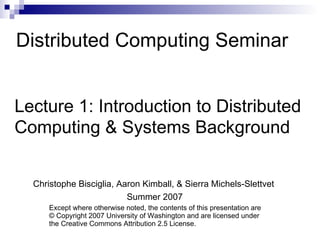
Lec1 Intro
- 1. Distributed Computing Seminar Lecture 1: Introduction to Distributed Computing & Systems Background Christophe Bisciglia, Aaron Kimball, & Sierra Michels-Slettvet Summer 2007 Except where otherwise noted, the contents of this presentation are © Copyright 2007 University of Washington and are licensed under the Creative Commons Attribution 2.5 License.
- 4. Computer Speedup Moore’s Law: “ The density of transistors on a chip doubles every 18 months, for the same cost” (1965) Image: Tom’s Hardware and not subject to the Creative Commons license applicable to the rest of this work. Image: Tom’s Hardware
- 15. Parallelization Idea (2) In a parallel computation, we would like to have as many threads as we have processors. e.g., a four-processor computer would be able to run four threads at the same time.
- 26. The “corrected” example Thread 1: void foo() { sem.lock(); x++; y = x; sem.unlock(); } Thread 2: void bar() { sem.lock(); y++; x+=3; sem.unlock(); } Global var “Semaphore sem = new Semaphore();” guards access to x & y
- 28. The final example Thread 1: void foo() { sem.lock(); x++; y = x; fooDone = true; sem.unlock(); fooFinishedCV.notify(); } Thread 2: void bar() { sem.lock(); if(!fooDone) fooFinishedCV.wait(sem); y++; x+=3; sem.unlock(); } Global vars: Semaphore sem = new Semaphore(); ConditionVar fooFinishedCV = new ConditionVar(); boolean fooDone = false;
- 29. Too Much Synchronization? Deadlock Synchronization becomes even more complicated when multiple locks can be used Can cause entire system to “get stuck” Thread A: semaphore1.lock(); semaphore2.lock(); /* use data guarded by semaphores */ semaphore1.unlock(); semaphore2.unlock(); Thread B: semaphore2.lock(); semaphore1.lock(); /* use data guarded by semaphores */ semaphore1.unlock(); semaphore2.unlock(); (Image: RPI CSCI.4210 Operating Systems notes)
Editor's Notes
- There are multiple possible final states. Y is definitely a problem, because we don’t know if it will be “1” or “7”… but X can also be 7, 10, or 11!
- Inform students that the term we want here is “race condition”
- Ask: are there still any problems? (Yes – we still have two possible outcomes. We want some other system that allows us to serialize access on an event.)
- Go over wait() / notify() / broadcast() --- must be combined with a semaphore!